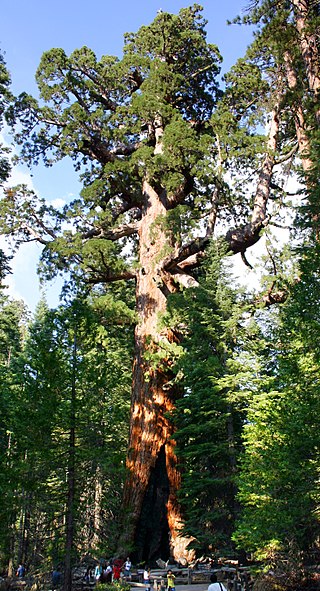
Sequoiadendron giganteum, also known as the giant sequoia, giant redwood or Sierra redwood is a coniferous tree, classified in the family Cupressaceae in the subfamily Sequoioideae. Giant sequoia specimens are the most massive trees on Earth. They are native to the groves on the western slopes of the Sierra Nevada mountain range of California but are grown around the world.

Pseudoscorpions, also known as false scorpions or book scorpions, are small, scorpion-like arachnids belonging to the order Pseudoscorpiones, also known as Pseudoscorpionida or Chelonethida.

Sambucus is a genus of flowering plants in the family Adoxaceae. The various species are commonly referred to as elder, elderflower or elderberry.

Harvey Weinstein is an American former film producer and convicted sex offender. In 1979, Weinstein and his brother, Bob Weinstein, co-founded the entertainment company Miramax, which produced several successful independent films including Sex, Lies, and Videotape (1989); The Crying Game (1992); Pulp Fiction (1994); Heavenly Creatures (1994); Flirting with Disaster (1996); and Shakespeare in Love (1998). Weinstein won an Academy Award for producing Shakespeare in Love and also won seven Tony Awards for plays and musicals including The Producers, Billy Elliot the Musical, and August: Osage County. After leaving Miramax, Weinstein and his brother Bob founded The Weinstein Company (TWC), a mini-major film studio. He was co-chairman, alongside Bob, from 2005 to 2017.

Steatoda nobilis is a spider in the genus Steatoda, known in the United Kingdom as the noble false widow, as it superficially resembles and is frequently mistaken for the black widow and other spiders in the genus Latrodectus. It is often referred to as thefalse widow, although "false widow" is a more general term applied to a wider group of species with this resemblance.[a] It is a moderately medically significant spider, with most bites resulting in symptoms similar to a bee or wasp sting. Some bites may cause more significant harm, partly due to pathogenic bacteria from the spiders.

The Batrachedridae are a small family of tiny moths. These are small, slender moths which rest with their wings wrapped tightly around their bodies.

The Calpinae are a subfamily of moths in the family Erebidae described by Jean Baptiste Boisduval in 1840. This subfamily includes many species of moths that have a pointed and barbed proboscis adapted to piercing the skins of fruit to feed on juice, and in the case of the several Calyptra species of vampire moths, to piercing the skins of mammals to feed on blood. The subfamily contains some large moths with wingspans longer than 5 cm (2 in).

Pterolonchidae is a small family of very small moths in the superfamily Gelechioidea. There are species native to every continent except Australia and Antarctica.
Chlorobaptella is a monotypic moth genus of the family Crambidae erected by Eugene G. Munroe in 1995. Its only species, Chlorobaptella rufistrigalis, was first described by William Barnes and James Halliday McDunnough in 1914. It is found in North America, where it has been recorded from California and Nevada. Moths in this genus are distinguished from moths in similar genera by their small palpi and obsolete tongues.
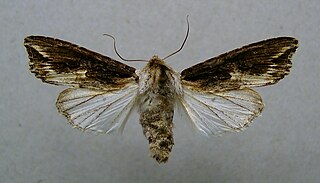
Egira is a moth genus in the family Noctuidae. This genus has several species, including Egira crucialis, that are on wing in winter and early spring. They are sometimes, along with members of the Orthosia genus, called early spring millers.
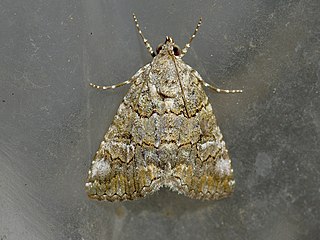
Eubolina is a monotypic moth genus in the family Erebidae. Its only species, Eubolina impartialis, commonly known as the eubolina moth, is found in the United States, mostly in southern Texas. Both the genus and the species were first described by Leon F. Harvey in 1875.

Euxoa is a genus of moths of the family Noctuidae raised to Genus by the German entomologist, Jacob Hübner. The Genus is mostly confined to dry and semi dry areas in the Northern Hemisphere. There 130 species in Eurasia, a few in Africa, and 175 in North America. There are no species in the Genus in South-East Asia or in Australia. In North America, most species are found in Western regions. Of the North American species, 4 are endemic to Mexico. There is one species recorded from Chile, but this may be a mislabeled specimen. In real terms, species numbers do not equal species abundance. Some areas with few species have large numbers of the ones that do live there.
Fala is a monotypic moth genus of the family Noctuidae. Its only species, Fala ptycophora, is found in the US state of California. Both the genus and species were first described by Augustus Radcliffe Grote in 1875.
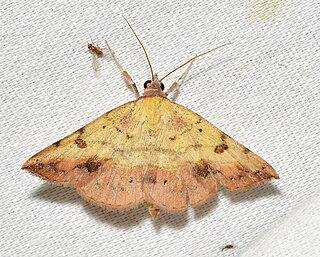
Hemeroplanis is a genus of moths of the family Erebidae. The genus was erected by Jacob Hübner in 1818.
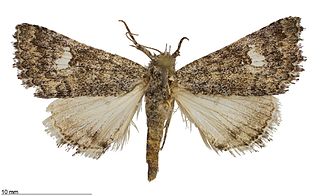
Heteranassa is a monotypic moth genus in the family Erebidae described by J. B. Smith in 1899. Its only species, Heteranassa mima, was first described by Leon F. Harvey in 1876. It is found in warm, arid habitats in North America from California to Texas, northward to Oklahoma, and south as far as Oaxaca in Mexico.

Orthosia is a genus of moths of the family Noctuidae erected by Ferdinand Ochsenheimer in 1816. As with the genus Egira, moths in this genus are sometimes called early spring millers, as adults are on wing in winter and early spring.
Sympistis figurata is a moth of the family Noctuidae first described by Leon F. Harvey in 1875. It is found in the United States east of the Cascade Range in Washington and Oregon.

Grotella septempunctata is a moth in the genus Grotella, of the family Noctuidae. The species was first described by Leon F. Harvey in 1875. It can be found in North America, from Texas to Colorado.

Apomyelois bistriatella is a species of snout moth in the genus Apomyelois. It was described by George Duryea Hulst in 1887. It is known from California, the eastern United States, northern Europe and Russia.
Loxostege immerens is a moth in the family Crambidae. It was described by Leon F. Harvey in 1875. It is found in North America, where it has been recorded from California.















